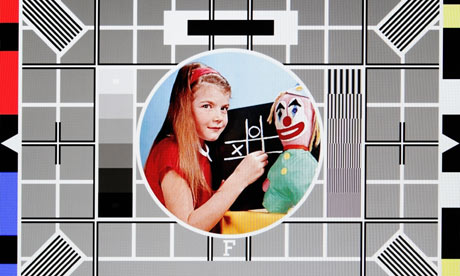
I wouldn't have missed Scooby Doo for the world, but a couple of times a week – during what, in the 1970s, was called Children's Hour – I would sit my portable cassette recorder on a stool next to the TV speaker and record the incidental music played on BBC2.
In the mid-70s, there were only three TV channels and very few programmes during the day. For long periods there was nothing but trade test transmissions, largely to enable TV shops to get the best possible picture. These transmissions were made up of the test card, with its instrumental soundtrack, and the occasional test film – such as The Home Made Car, a 1963 Academy Award-nominated short. During the school holidays, or on Saturday mornings before your parents were up, there was little else for bored kids to do but watch the test card and transmitter information – the music and the images became as embedded in the minds of a generation as the Monkees and the Robinson Crusoe theme.
I ended up with a collection of C60 cassette tapes containing things like (though I had no idea what they were at the time) Norrie Paramor's version of the M*A*S*H* theme and Andre Brasseur's The Kid, probably the only record played both on the test card and at Wigan Casino. The liberal use of European synth instrumentals, vocalese jazz, even bits of Bach, informed my tastes – the test card may not have primed me for punk, but I really understood where the Pale Fountains and Portishead were coming from. Come the 90s and the lounge music boom, I was fairly sure I wasn't the only kid who'd been watching the test card.
The most iconic image, introduced in 1967 with the advent of colour TV, was called Test Card F. Its designer was a BBC engineer called George Hersee and, for a dummy run, he had included a picture of his eight-year-old daughter, Carole, at the centre of it. The BBC decided that replacing Carole's picture with an adult model was too risky – they needed something timeless, and 1967 fashions weren't exactly built to last. So Carole went into a photographer's studio: the result was the familiar image of a girl with an alice band, playing noughts and crosses with a rather terrifying toy clown, surrounded by mysterious test graphics. Hersee was, unsurprisingly, teased at school and, to her discomfort, the image was used on a daily basis until 1998. Now living in the New Forest with two daughters, she can claim to have had more screen time – around 70,000 hours – than anyone else in British TV history.
For children the image seemed incredibly important. For girls, the Mona Lisa-like image of Carole Hersee was a role model – I know a DJ in Wales who dressed like her as a child, even carrying a cuddly clown around; someone else I know thought she was the most beautiful girl in the world (no, it wasn't me). Later on in life, the image of Carole Hersee became more associated with waking up on the settee at three in the morning with the telly still on and empty beer cans on the floor. Her face never changed; the game of noughts and crosses never ended. It was once compared to a Home Counties version of the Seventh Seal.
But it was the testcard music that hooked me. The BBC regularly received letters from the public asking where they could buy it; the short answer was: they couldn't. The man who chose the music in the 70s was John Ross-Barnard, who worked in the BBC's Foreign Recordings Department: "People wrote in – can I have a copy? But it wasn't ours. It came from music libraries, and a huge exchange of material between European broadcasters. The public would receive a photocopied letter saying the music wasn't for sale. It was an embarrassment, in a way."
As is often the case, the BBC hasn't kept an archive of his tapes, but a group of enthusiasts called the Test Card Circle have spent years piecing them together and occasionally issuing them on CD. Members meet in Leominster every year and swap tapes and obscure scraps of information – Ceefax music from the 80s and 90s, apparently, is creeping up in popularity among younger members. "People think it's gone but you can still hear the music on late-night BBC2," says TCC member John Flannery. "When the Learning Zone isn't on they'll show Ceefax, page 152. But that will go in October." What will replace Ceefax after the digital switchover, and how will the BBC fill those empty hours created by Mark Thompson's cutbacks? It's obvious, says Flannery: "They'll have to bring back the test card."
• A Girl, a Clown, a Blackboard: Trade Test Transmissions is at the ICA, The Mall, London SW1, 7pm, 25 April

